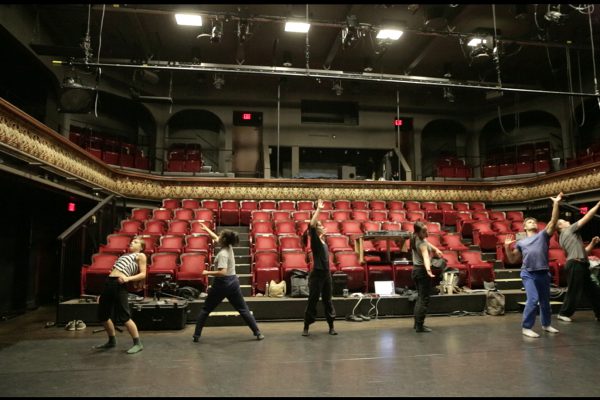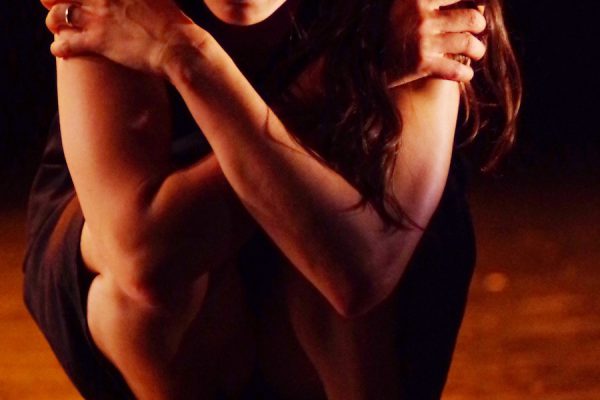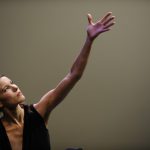It’s rare that a dance artist means so much to so many people. Yet Margie Gillis is that exception. The fact that she’s been able to connect with audiences, like no other, for the better part of forty years, is even more exceptional. In her recent celebratory anniversary concert at the Agora de la danse in Montréal, Florilège: 40 ans de poèmes chorégraphiques, Gillis reflects on her younger self and her singular career. It is a show where, amazingly, the past becomes visible, at least in my mind’s eye, and I’m convinced many in the theatre had the same experience. While it’s true that you can never recapture the past, recalling history can be illuminating.
The production unites five of her works, stretching from Waltzing Matilda (1978), to Broken English (1980), to The Little Animal (1986), to Bloom (1989), to Voyages (1997). As the performance progressed, I was pulled back to my own youth, not simply to where I was when I saw those performances, but to thoughts triggered about my own life at the time. Gillis is not just prompting us to remember phases of a great artist’s glory days, she invites us to revisit the intricacies of the dances, gently tinkered with in certain passages, yet embodied by a still-flourishing performer. There’s a simple honesty in her performance; nothing is forced. Watching her in motion as she enters her sixties you sense that she is being true to herself, and she brings enormous conviction to her dancing. Further, she’s compassionate toward the characters she inhabits. I brought a friend along to the show, someone who rarely goes to dance shows and had never seen Gillis dance, but his comments that “the movements are expressive, suggestive and symbolic” were totally on point.
Audiences, arguably, like character and story in certain dance works, and devotees of Margie Gillis are drawn to her physical narratives and the emotional continuity of her pieces. The “nouvelle danse” crowd in Québec, however, never embraced Gillis. That must have hurt, but she has moved beyond the old school vs. new school mentality and its divisions. Her storytelling device is best served (and it’s always been the case) when she chooses simple staging, costumes and movement coupled with stirring music. Over the years, we’ve watched her responsive body, her quirks, her triumphant joy in dancing – and then there was always the hair, an uncredited partner in these solos.
There are degrees of anguished intensity to some of the work, while certain pieces unfold grand themes of adulthood and express unhealed emotional wounds. The stage comes to life with Waltzing Matilda. Danced in six powerful minutes, with Gillis wearing an airy, floral dress, the piece felt right in a different way than it did almost forty years ago. Of course, her body doesn’t move with the same alertness, yet the weight and the overall slower tone in the swoop of her body, the footfalls, and the ways in which the movements swell and shrink in this signature work (which is set to Tom Waits’ haunting vocals in Tom Traubert’s Blues with a refrain from the Australian song, Waltzing Matilda), still resonate. What I recall of what I saw so long ago was an evocation of a sad, roaming man, filled with despair, drowning his sorrows, remembering the young woman who ripped his heart out and left him, travelling without the saints (there’s a reference to St. Christopher in the lyrics). Today, as Gillis dances it, the woman in question has matured and seems repentant about the things she’s done and regretful of the chances she let go.
The sequence for The Little Animal appears pared down from the original, but Gillis’s tortured and tender evocation of this creature being tamed inspires. In the stunning Bloom, Irish actress Siobhán McKenna’s riveting reading of the James Joyce soliloquy from Ulysses fills the space. It’s one of Gillis’s most dramatic performances, period, full of power and sensual potency, not to mention intelligence and wit, matching the author’s extraordinarily lyrical stream-of-consciousness writing.
Marianne Faithful’s combative Broken English is the epitome of the culture-clash politics of the 1980s, denouncing the masters of war. Gillis makes you feel like you’ve been through the wringer with her. The stomping physicality is less explosive than it used to be – in particular those tumbling dives are gone – but the anger and the “up yours” stance is ever clear. The final piece, the scene for Voyages, using Gilles Vigneault’s poetic Si les bateaux as source material for the score, had a moonlit black-and-white quality, with Gillis employing two valises as props, an ode to a life left behind and a pull to the new world.
Throughout this soulful concert, you feel Gillis’s’ ecstasy as a dancer. She ends most pieces with her head tilted up, as if toward the light. The hope, and even the innocence, that Gillis brought to her interpretations earlier in her career surfaces only fleetingly, but her way of moving today provides a different reading. There’s spiritual passion that she’s embedded in the work, providing a communion with the audience that transcends time. That evolution is radical not only for the deep pleasures it delivers, but for the way it reflects a sensitive and enduring imaginative vision.
Tagged: 360 Dance, Contemporary, Performance, Montréal , QC





